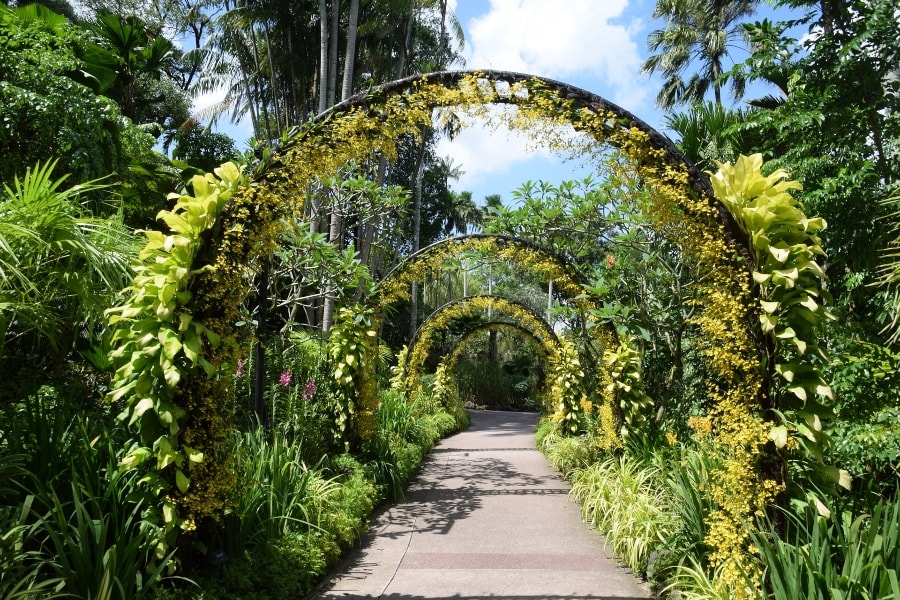“This is not a world with trees in it. It’s a world of trees, where humans have just arrived.” – Richard Powers, The Overstory.
And at the Singapore Botanic Gardens, this rings true. Wizened and gnarled, slender and shapely, trees and plants of over 10,000 species grow in a thousand green hues at the 161-year-old park. For each venerable bough and branch, tropical flora blossoms, in vibrant colour and aromatic perfumery.
Careful curation and conservation over the years has resulted in a modern model of green urbanism — an unexpected oasis amid a concrete jungle. Beyond its lush sculpted landscapes is a heritage charm that easily makes the Botanic Gardens a superlative park for relaxation in the city. Here’s why it tops the list of parks in Singapore:

Rich history
The gardens has evolved into a leading tropical botanical institute since its humble beginnings in 1859. Artefacts of its deep historical and cultural value lie on its grounds, in the form of lofty trees and hardy barks.
The Heritage Trees Walking Trail pays homage to this fact with seven living legacies of Singapore’s green heritage. Look for the Rubber Tree — a tall, spindly tree with smooth, greying bark. While it’s known that Singapore exported rubber during the industrial revolution, it’s lesser known that the Botanic Gardens was the source of the rubber trees that kickstarted the industry in Asia.
Experimentation was in vogue back then, and the director of the gardens, Henry Nicholas (H. N.) Ridley, was a botanist on a mission. He not only cultivated rubber saplings that had failed to grow in British climates into healthy trees but went on to invent the only method of rubber tapping that could extract rubber sap without killing its host. This discovery coincided with the explosive growth in demand for rubber during World War II and a burgeoning automobile industry; and the rest, as people say, is history.
Today, the Singapore Botanic Gardens is the only tropical botanic gardens that is inscribed as a UNESCO World Heritage Site in the world as its inhabitants have not just impacted the country’s landscape, but the society and economy at large.
Unique places of interest
Spanning 82-hectares, the Singapore Botanic Gardens is a verdant sanctuary of cosy alcoves and airy pavilions. While there are numerous places of interest to fill up your day with, there are even more to let your hair down. Having visited many times, there are a few places that never get old.
Palm Valley
Gawky, feathery palms line the wide, expansive space that is Palm Valley. This place is beloved for its openness, and convenience of location (it is situated right next to Symphony Lake which holds the occasional orchestral production).
Amazingly, while it is close to the touristic but beautiful National Orchid Garden, it remains relatively chill and serene. Find an empty nook amid the palm trees, lie down and watch the clouds go by, read a book, or picnic. You’ll find it easy to enjoy your little slice of calm in palm tree haven.
Rainforest
One of the oldest remnants of Singapore’s primary rainforests, the Rainforest is a beautiful reminder of Singapore’s evolution from rural village to cosmopolitan city. Take the Rainforest Walking Trail to immerse yourself into a clandestine world of tropical vegetation and monolithic trees.
Swan Lake
Named after the beautiful white (and black) swans that grace the lake, Swan Lake is a popular attraction in the Singapore Botanic Gardens, not least because it is the oldest ornamental water feature in the city. It is a breath of fresh air for those seeking a charming spot to relax in the gardens.
Quiet sanctums
There’s something for everyone, and off-the-beaten-track areas within the park continue to provide safe shelters for those seeking to retreat from the world for a couple of hours. These include:
Eco-lake
The eastern side of the park (Bukit Timah Gate) tends to be lesser explored, and Eco-lake is the main attraction offering refreshing respite in the area. Trim, spruced-up lawns surround the peaceful lake, making for an idyllic setting to unwind and destress from the bustle of a busy lifestyle.
Sundial Garden
While the focal point is the 1929 bronze sundial that sits in the middle of the garden, its jade green water lily ponds add ambience to the tranquil setting of the little glade. Pavilions can be found at either end of the garden, and provide a great resting space for those who stumble upon it.
Frangipani Collection
An assembly of garden swings entice the passing visitor to linger at the Frangipani Collection, and engage in a moment of suspended delight. Under the shade of the elegant Frangipani trees, it becomes easy to let your woes and worries temporarily slip away.
Curtain of Roots
Wispy and dream-like, aerial roots belonging to the Princess Vine, a close relative of the common grape, hang down in a veiled curtain of red. While the Curtain of Roots is a short pathway, it provides an exclusive, almost private experience of calm and quiet.
The Verdict?
The Singapore Botanic Gardens is touristic, but still manages to harbour pockets of peaceful sanctuaries perfect for a lazy afternoon. Just like the Central Park is to New Yorkers, the Botanic Gardens is to this Singaporean the representative recreational parkland of the city.














